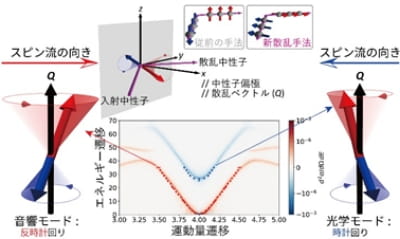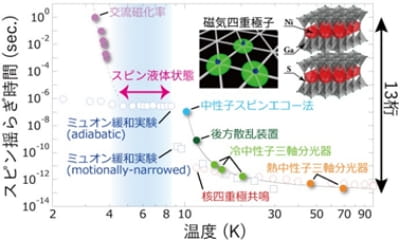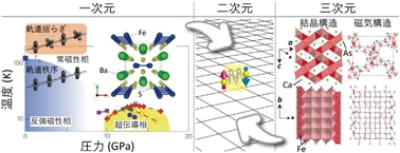Research
Experimental methods used in condensed matter physics research can generally be divided into either macroscopic or microscopic measurements. Macroscopic physical properties such as electrical resistivity, magnetic susceptibility, and specific heat, that can emerge on a large scale compared to atomic size. Most of these measurements can be performed at laboratories, and are generally applied to newly developed materials. On the other hand, microscopic measurements contain methods for observing a small area in real (positional) space and reciprocal (momentum) space via means of scattering. Given that these measurements can be conducted at large facilities, one may presume them challenging to carry out and interpret results.
However, for the precise understanding of physical phenomena, views from a microscopic point are needed. Our group takes a research style that tackles novel quantum phenomena based on various methodologies by combining crystal growth and characterisation by ourselves, macroscopic measurements in the laboratory, and microscopic measurements, including neutrons, muons and X-ray, at facilities worldwide.
Spintronics
 Spintronics
Spintronics
In spintronics research, creation, annihilation, and control of the spin current—a flow of the spin degree of freedom—have been one of the main topics. Spin current propagates over the whole momentum (Q) space. However, the detection has been limited to the long-wavelength limit (Q = 0) by voltage measurement through the inverse spin Hall effect. To better control and achieve high efficiency of the spin current, information based on the microscopic viewpoint, such as the diffusion length and lifetime, is needed. Besides that, energy (E)-dependent information of spin currents is also required for future applications realised at room temperature.
In insulators, spin current can be propagated by the precessional motion of electronic spins, but there has been no evidence for that. We estimated from calculations that the precessional motion could be detected using polarised neutrons, and succeeded in directly observing it for the first time [1,2]. This is actually a new polarised neutron scattering technique, and we applied it for the ferrimagnetic Y3Fe5O12. We experimentally observed that the directions of the precessional motions in the acoustic and optical magnon modes are opposite from each other, and therefore the spin currents are propagated in the opposite directions. In addition to the ferrimagnetic insulators, we got interested in spin current propagation by spin triplets [3], by higher degrees of freedom, and antiferromagnetic spintronics.
- Y. Nambu, J. Barker, Y. Okino, T. Kikkawa, Y. Shiomi, M. Enderle, T. Weber, B. Winn, M. Graves-Brook,
J. Tranquada, T. Ziman, M. Fujita, G.E.W. Bauer, E. Saitoh, and K. Kakurai, Physical Review Letters 125, 027201 (2020). Editors' Suggestion - Y. Nambu and S. Shamoto, Journal of the Physical Society of Japan 90, 081002 (2021). (Special Topics: Renewed Interest in the Physics of Ferrimagnets for Spintronics)
- Y. Chen, M. Sato, Y. Tang, Y. Shiomi, K. Oyanagi, T. Masuda, Y. Nambu, M. Fujita, and E. Saitoh, Nature Communications 12, 5199 (2021).
Frusttrated magnetism
 Frusttrated magnetism
Frusttrated magnetism
Novel magnetic states of matter that appear when a magnetic order is suppressed, have long attracted much attention. Given that conventional theory cannot be applied to such a state, close investigations of the spatial/temporal correlations of spins would be a high priority. Diffraction techniques are usually used for spatial correlation, but there have been so far few studies focusing on the temporal correlation. We focus on the triangular antiferromagnet NiGa2S4 that does not show any magnetic order, and quantitatively trace the spin fluctuation time over 13 orders of magnitude. Our experimental findings via neutrons, muons, and AC magnetometry directly show an interesting viscous spin liquid state with MHz fluctuation [1].
Spin-size dependence [2] and Raman scattering [3] studies have revealed that this magnetic state possesses a high-order magnetic quadrupole correlation. In addition, the anomaly toward MHz fluctuation turns out to be owing to another high-order chirality-driven topological transition. Since the neutron can correlate with magnetic dipoles (spins), it is challenging to observe the higher degree of freedom directly. We aim to detect these by developing new scattering techniques.
- Y. Nambu, J.S. Gardner, D.E. MacLaughlin, C. Stock, H. Endo, S. Jonas, T.J. Sato, S. Nakatsuj, and C.Broholm, Physical Review Letters 115, 127202 (2015).
- Y. Nambu, S. Nakatsuji, Y. Maeno, E.K. Okudzeto, and J.Y. Chan, Physical Review Letters 101, 207204 (2008).
- M.E. Valentine, T. Higo, Y. Nambu, D. Chaudhuri, J. Wen, C. Broholm, S. Nakatsuji, and N. Drichko
Physical Review Letters 125, 197201 (2020). - Y. Nambu, K. Aoyama, H. Kawamura, T. R. Gentile, W. Chen, S. Watson, and Y. Qiu, submitted.
Iron-based superconductivity
 Iron-based superconductivity
Iron-based superconductivity
Iron-based superconductivity attracts attention as systems with high transition temperatures next to cuprates. Iron was considered to unstabilise superconductivity, so the discovery of iron-based superconductivity in Japan gave a high impact. Unlike copper with the quenched orbital degree of freedom, multi-orbital electrons are key to understanding superconductivity. We focus on iron-based materials with different spatial dimensions rather than two to elucidate the pairing mechanism using simpler geometries. Superconductivity generally depends on the shape of the Fermi surface, magnetic order, and electron correlation. Changing the spatial dimensionality may lead to the clarification of the pairing mechanism on simpler geometries.
By combining magnetic structure refinements through group-theoretical analysis in three-dimensional [1] and one-dimensional systems [2] with various collaborations, we have shown that electronic correlations and magnetic structures can be interpreted as functions of some parameters in crystal structures. Furthermore, for the first time, we succeeded in inducing superconductivity in a one-dimensional system [3]. The importance of orbital degrees of freedom in iron-based materials is also evidenced by our study [4]. We work on direct observation of the orbital degrees of freedom using polarised neutron scattering.
- Y. Nambu, L.L. Zhao, E. Morosan, K. Kim, G. Kotliar, P. Zajdel, M.A. Green, W. Ratcliff, J.A. Rodriguez-Rivera, and C. Broholm, Physical Review Letters 106, 037201 (2011).
- Y. Nambu, K. Ohgushi, S. Suzuki, F. Du, M. Avdeev, Y. Uwatoko, K. Munakata, H. Fukazawa, S. Chi, Y. Ueda, and T.J. Sato, Physical Review B 85, 064413 (2012).
- H. Takahashi, A. Sugimoto, Y. Nambu, T. Yamauchi, Y. Hirata, T. Kawakami, M. Avdeev, K. Matsubayashi, F. Du, C. Kawashima, H. Soeda, S. Nakano, Y. Uwatoko, Y. Ueda, T.J. Sato, and K. Ohgushi, Nature Materials 14, 1008 (2015).
- S. Hosoi, T. Aoyama, K. Ishida, Y. Mizukami, K. Hashizume, S. Imaizumi, Y. Imai, K. Ohgushi, Y. Nambu, M. Kimata, S. Kimura, and T. Shibauchi, Physical Review Research 2, 043293 (2020).